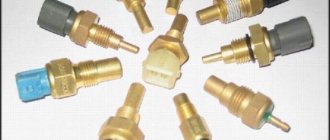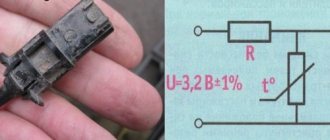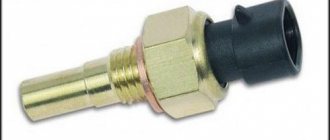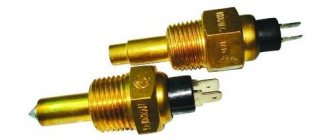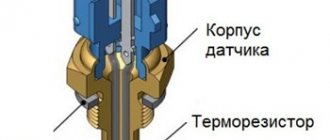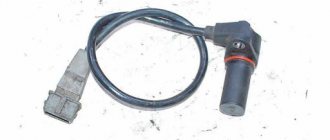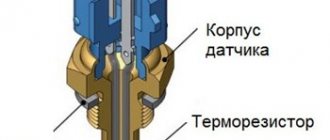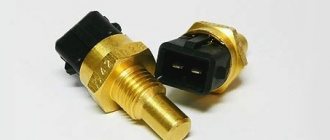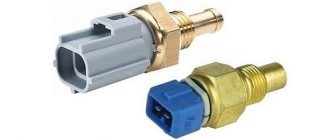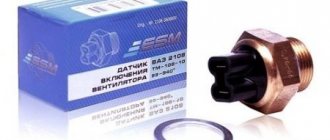Purpose of the sensor
Coolant temperature sensor (CTS) Grants are necessary not only for measuring the temperature of antifreeze, but also for other purposes. For example, another function of the sensor is to participate in adjusting the fuel mixture, namely, based on the resistance readings of the sensor, the ECU makes a change to the fuel mixture.
When the car is cold and its coolant is low, more fuel is needed to start the engine in such weather, so the ECU, receiving information from the sensor that the fluid is cold, enriches the fuel for easier starting and efficient warming of the car.
Likewise, and vice versa, when the engine is warm, the engine requires less fuel to start; therefore, the engine can be started with a leaner mixture, thereby saving some amount of fuel.
The operation of the sensor is easy to notice when starting a cold engine, when the speed of a newly started engine is slightly higher than idle, around 1300 rpm.
Replacing the Lada Granta temperature sensor (VAZ Granta)
The sensor is installed in the engine cooling system. The sensitive element of the sensor is a thermistor, the electrical resistance of which varies inversely with temperature.
The Lada Granta coolant temperature sensor is a thermistor (a resistor whose resistance changes depending on the temperature).
The sensor is screwed into the thermostat housing and connected to the controller input, connected to an internal voltage source of 5 V through a 2 kOhm resistor. At low temperatures, the resistance of the sensor is high, and at high temperatures it is low (Table 1). The controller calculates the coolant temperature from the voltage drop on the sensor.
On a cold engine the voltage drop is high, and on a warm engine it is low. Coolant temperature affects most of the characteristics controlled by the controller.
To remove the sensor you will need: a 19mm wrench and a multimeter.
If you have a 21126 engine, then you can see the algorithm for removing the sensor in the article “Replacing the coolant temperature indicator sensor in Lada Priora”
1. Disconnect the wire from the negative terminal of the battery.2. Partially drain the coolant from the radiator.3. For ease of operation, remove the air filter (see “Removing and installing the air filter, air supply hose and air intake of the Lada Granta”).4. Release the wiring harness block clamp
5. and disconnect the block from the sensor.
6. Unscrew the sensor from the thermostat housing.
7. Remove the sensor.
Check the sensor in ohmmeter mode, connect probes to the sensor terminals and measure its resistance. Measure the current air temperature with a thermometer and compare the obtained values with the data in the table. 1. If the resistance deviates from the norm, replace the sensor.
9. To measure the resistance at the sensor terminals at different temperature conditions, lower the sensor into hot water and check the change in its resistance as the water cools, monitoring the water temperature with a thermometer. Nominal resistance values at various temperatures are shown in table. 1.10. Install the sensor in the reverse order of removal
Tools:
- Ratchet wrench
- Extension
- 8 mm head
- 10 mm head
- 19 mm head
- Medium Phillips screwdriver
- Ohmmeter (tester)
Parts and consumables:
- Coolant temperature sensor
- Technical capacity
- Container for hot water (glass, mug)
- Water thermometer
- Household thermometer
- Hot water
- Rags
1. Disconnect the wire from the negative terminal of the battery.
2. To access the radiator drain holes, remove the middle mudguard as described here.
3. Partially drain the radiator coolant as described here.
4. To make it easier to replace the DTOZH sensor, remove the air filter as described here. Take him aside.
5. Press the lock of the DTOZh sensor wiring harness connector and disconnect the connector from the sensor (it is located on the cooling system thermostat).
6. Using a wrench with an extension and a 19 mm socket, unscrew the DTOZH from the thermostat.
7. Remove the sensor.
8. Cool the DTOZh sensor to ambient temperature.
9. Connect the tester in ohmmeter mode to the terminals of the DTOZH sensor and measure its resistance.
10. Measure the current air temperature with a thermometer and compare the obtained values with the data presented below.
11. To measure the resistance at the terminals of the DTOZh sensor at different temperature conditions, lower the coolant temperature sensor into hot water and check the change in its resistance as the water cools, monitoring the water temperature with a thermometer. Nominal resistance values at various temperatures are indicated in the table (see paragraph 10).
12. If the resistance deviates from the norm, replace the DTOZh sensor.
13. Install the coolant temperature sensor on the vehicle in the reverse order of removal.
First, it’s worth understanding why temperature meters are needed in a car. It is completely clear what internal and external air temperature meters do. They carry out their measurements, transmit a signal to the car’s ECU, and thanks to their work, the car either carries out climate control, or regulates the operation of the car’s mechanisms, or simply displays the obtained measurements on the dashboard (however, this is often done bypassing the ECU altogether).
Why, for example, do you need a coolant temperature sensor (DTOZH)? His work, although it seems just as obvious, is actually deeper in nature.
After all, the coolant travels a long way, through the engine to the radiator, and then, wobbling through its tubes, returns to the engine, where it is re-measured.
The radiator is designed in such a way that air flows counter to the car cool the antifreeze without unnecessary costs on the part of the car. However, in hot weather or standing in a traffic jam, this may not be enough, and then the computer decides to turn on additional cooling in the form of fans located inside.
At the same time, the Lada Granta DTOZH, with its measurements, helps the computer determine the need for additional fuel injection. Although more often devices that measure incoming air or outgoing air (exhaust) are responsible for this.
As a result, the main positive criteria for the work of the DTOZh include:
- reduction in fuel consumption;
- reducing wear on machine mechanisms;
- improving vehicle performance and avoiding overheating.
This can also include bonuses such as notification to the driver or analysis of the operation of one or another form of coolant. But this already depends on the ability of the drivers themselves to recognize such signals.
The coolant temperature detector in the Lada Granta is installed on the thermostat housing. To work with it, you will need standard tools like a Phillips screwdriver, two pairs of hands, and perhaps a 19 mm deep socket to simplify the work.
The dismantling of the meter in the Lada Granta itself takes place in several stages:
- we find where the device is located, remove the air filter that prevents us from getting to it;
- disconnect the wires from the meter;
- remove the connector from the detector;
- Let's start unscrewing the device.
Before dismantling, be sure to turn off the power to the car by removing the terminal from the battery. After this, be sure to drain the coolant. Failure to comply with any of these conditions poses a threat to your life and health.
Installation of a new device occurs in reverse of its dismantling. That is, they screwed it in, put the wires back in place, and put the air filter back. After that, we poured back the antifreeze and connected the electricity. However, two installation nuances should be remembered. The first is to convince yourself of the quality of the seal of the new sensor or add your own sealant (coolant should not leak out while the car is running). Well, the second comes out of the first - start the car and make sure there is no antifreeze leakage.
Repairing the Lada Granta DTOZ is easy and simple. At the same time, the benefits of the device are difficult to overestimate. Therefore, the logical conclusion is made that you should not neglect replacing a failed meter. Replacement should be done immediately.
The absence of a working DTOZh leads to the immediate activation of the additional cooling system, even if there is no need. As a conclusion, this leads to unjustifiably high fuel consumption during vehicle operation.
Replacing the DTOZH sensor REASONS and a little about air leaks.
Checking the DTOZH
The sensor is checked using a multimeter and a glass of boiled water with a thermometer.
To do this, set the switch on the multimeter to the resistance measurement parameter.
The probes of the multimeter are connected to the sensor, and the sensor itself is placed in a glass of boiling water.
Next, a thermometer is dipped into the glass to measure the water temperature.
The water temperature reading should be compared with the resistance reading of the multimeter and compared to the original table.
If the readings agree, then the sensor is working.
Temperature sensor T811 | Server room environment monitoring
Temperature sensors A (T811) are designed to measure indoor air temperature without the possibility of water entering the sensor housing. The sensors are made in the form of a board mounted on a plastic case with slots.
Thermal sensors (T811) are connected to NetPing 2 / PWR-220 v4 / SMS, NetPing 2 / PWR-220 v3 / ETH IP power distribution units (IP PDUs). Information on connecting temperature sensors (T811) is given in the “User Manual” documents of the corresponding NetPing IP PDUs to which they are connected. Information on setting up temperature sensors (T811) is given in the “Firmware Description” documents of the corresponding NetPing IP PDUs to which they are connected.
All server room temperature sensors are connected in parallel to each other to the same contacts. The sensor model is indicated on the body of each digital temperature sensor. Before using the air temperature sensor, you must set the temperature sensor address yourself. The temperature sensor address is set by removing the temperature sensor board from the case and installing mechanical switches (jumpers) in a certain place using a screwdriver included with the NetPing power distribution units, or manually:
Lada Granta car temperature sensor
Such a seemingly insignificant part of the car as the temperature sensor of the Lada Granta is one of the most important control and measuring instruments of the car. The safe operation of an internal combustion engine (ICE) depends on its serviceability. A timely identification of the cause of a sharp increase in coolant temperature will save the vehicle owner from troubles on the road and large unexpected costs.
Grant no engine temperature gauge
Lada Granta (2019). The engine is overheating (the engine overheating warning light is on)
| List of possible faults | Diagnostics | Elimination methods |
| Thermostat is faulty | Check that the thermostat is working properly | Replace the faulty thermostat |
| Insufficient coolant | The fluid level is below the “MIN” mark on the expansion tank | Fix leaks. Add coolant |
| Lots of scale in the cooling system | — | Clean the cooling system with a descaling agent. Do not use hard water in the cooling system. Dilute concentrated antifreeze only with distilled water. |
| Radiator cells are dirty | Inspection | Flush the radiator with pressurized water |
| Coolant pump faulty | Remove the pump and inspect the assembly | Replace the pump assembly |
| Cooling fan does not turn on | Check the fan circuits | Restore contact in electrical circuits. Faulty fuse, relay, cooling fan, temperature sensor, ECU - replace |
| Unacceptably low octane number of gasoline | — | Fill your car with fuel recommended by the manufacturer |
| A lot of carbon deposits in the combustion chambers, on the piston heads, valve plates | Inspection after removing the engine cylinder head | Eliminate the cause of carbon formation (see faults “Increased fuel consumption”, “Increased oil consumption”). Use oil of the recommended viscosity and, if possible, low ash content. |
| Exhaust gas breakthrough into the cooling system through a damaged cylinder head gasket | There is a smell of exhaust gases in the expansion tank and bubbles float to the surface | Replace the cylinder head gasket. Check for flatness of the cylinder head |
Causes of engine overheating
1. Lack of fluid
The most common cause of overheating is insufficient coolant in the cooling system. Liquid, as you know, will always find a way to leak out if there is even the slightest hole. In a cooling system with a bunch of tubes, pipes, clamps and gaskets, there may be several such holes. So the antifreeze gradually leaves both the expansion tank and the radiator of the cooling system. READ ALSO: How to protect yourself and your car from heat and sun This problem can be identified by white streaks on the outer surfaces of the engine, drops of antifreeze under the car after a long period of parking. All leaking elements of the cooling system must be replaced.
2. Problems with the radiator
If the fan is driven by a belt from the crankshaft, the tension of this belt may weaken. If the fan drive is electric, the temperature sensor may malfunction. Check these elements - they often provoke further problems. Then make sure the cooling system radiator fins are kept clean. If dirt has stuck to them, then overheating will occur very quickly - it is best to wash the radiator with a strong stream of water once every 2-3 years. READ ALSO: How to prepare your car for the start of the hot season
3. Problems with the thermostat
As deposits accumulate in the cooling system, the mobility of the elastic element of the thermostat is lost, and it stops responding to the temperature of the antifreeze leaving the engine. Then it all depends on the position in which it hangs - either it will constantly begin to drive liquid along a large circuit, and the engine will be more difficult to warm up; or in small ways, then overheating is inevitable. Very often, the thermostat jams after tap water has been poured into the cooling system - it is hard, with a high content of salts and minerals, which are immediately deposited in the cooling system. If you had to do this, then you need to replace it with antifreeze as quickly as possible. But you still need to carry water with you: you often have to urgently add coolant (preferably distilled). A faulty thermostat needs to be replaced urgently. But if it is expensive, then at least wash it by pouring a hot mixture of water and citric acid, Calgon or “Mole” into the cooling system - these substances clean well and dissolve everything unnecessary.
What to do if you overheat
Causes that can be identified and some that can be eliminated
Combustion chamber seal failure
What not to do when the engine is boiling
Prevention
In addition, overheating of the engine can occur if the wrong mode of operation of the motor is selected. For example, if you constantly drive only in lower gears and at high speeds, then the likelihood of the engine boiling increases, especially if there are deviations in the operation of the cooling system. In the cold season, some errors are not affected by low temperatures, but this does not mean that engines boil only in the summer.
Why does coolant boil?
Sometimes you can see a car standing on the side of the road with the hood raised, from under which steam is pouring out. This is the result of a failure of the Lada Granta temperature sensor. The device provided incorrect information to the electronic control unit (ECU), and the ventilation system was unable to operate in time, which is why the antifreeze began to boil.
If the coolant temperature sensor (DTOZh) on the Lada Granta is faulty, the antifreeze may boil for several reasons:
- Loose timing belt.
- Destruction of the pump bearing.
- Thermostat failure.
- Antifreeze leak.
Loose timing belt
The belt tension may become weak due to the exhaustion of its running life or poor manufacturing quality. The belt begins to slide along the teeth of the pump drive gear. The speed of movement of antifreeze in the radiator drops, and the temperature sharply “flies” upward. The belt is tightened or replaced with a new product.
Pump bearing failure
The consequence of a failure of the coolant pump bearing is that the pump begins to jam. Antifreeze stops moving inside the large cooling system circuit on the Grant, and the liquid, quickly heating up, reaches the boiling point of 100 ° C. The pump is urgently dismantled and replaced with a new pump.
Thermostat failure
Over time, the device may exhaust its resource, and the valve stops working when the antifreeze heats up. As a result, antifreeze cannot circulate in a large circuit and pass through the radiator. The liquid, remaining in the engine jacket, quickly heats up and boils. The thermostat needs urgent replacement.
Antifreeze leak
This can happen due to leakage in the connections of the cooling system pipes, damage to the radiator, expansion tank and pump. A low antifreeze level can be seen by the marks on the expansion tank. This will also be noticeable by how quickly the needle moves or the temperature values change on the instrument panel interface. You need to add fluid to the required level and go to the garage or service station.
Speed sensor
The DS is intended to measure the speed of a vehicle, with subsequent transmission of the received data to the ECU. The speed sensor is a small part; it is located in the upper part of the clutch housing, near the front wheel on the right. Its malfunction is usually directly related to a breakdown of the speedometer. However, the sensors installed on Grants are distinguished by fairly high quality and durability.
By the way, initially three types of speed sensors were installed on Grants: VAZ-2170 PEGAS, 2190 AVAR Russia and 21700-3843010-02.
More details about the speed sensor on Grants.
If the DS malfunctions, the electric power steering most often stops functioning, and at the same time the instrument panel begins to display error P-0501. As a rule, the steering wheel fails precisely because the car detects a breakdown of the speed sensor; the DS itself may show zero speed.
If the sensor fails, the following symptoms of failure are noted:
These parts have their own markings, their price ranges from 300 to 600 rubles.
Purpose
The process of ignition of the fuel mixture in the cylinders of the internal combustion engine is accompanied by an increase in temperature to 20000C. If you do not maintain operating temperature conditions, the cylinder block with all its parts will simply collapse. The purpose of the engine cooling system is precisely to maintain the thermal operating conditions of the engine at a safe level.
The Grant engine temperature sensor is a meter that tells the ECU about the degree of heating of the antifreeze. The electronic unit, in turn, analyzing data from all sensors, including DTOZH, brings all internal combustion engine systems to a balanced optimal operating mode.
Motor temperature
It turns out that the temperature regime in which internal combustion engines operate depends very little on the ambient temperature.
To a greater extent, this indicator is influenced by the design, as well as the operating features of a particular unit. From a design point of view, motors are distinguished by the cooling method, design, type of fluids used, materials, compression, presence of supercharging, operating speed, and level of wear. So, in each individual case the operating temperature of the engine is different. There are also quite a lot of factors that influence the regime.
High temperatures are very harmful to any motor, regardless of its design. Therefore, you need to maintain the correct temperature regime.
Design and principle of operation
The temperature meter on Grant is a thermal variable resistor. The thermocouple, enclosed in a bronze case with a threaded tip, reduces the resistance of the electrical circuit when heated. This allows the ECU to determine the coolant temperature.
If you look at the sensor in cross-section, you can see two contact petals located at the top and bottom of a thermistor made of a special metal alloy, which changes its resistance depending on the degree of heating. It closes both contacts. One is supplied with power from the on-board network. The current, having passed through a resistor with a changed characteristic, exits through the second contact and enters the ECU microprocessor through the wire.
The following parameters of internal combustion engine operation depend on the DTOZH:
- temperature indicator readings on the instrument panel;
- timely activation of the internal combustion engine forced cooling fan;
- enrichment of the fuel mixture;
- engine idle speed.
Operating temperature of 8-valve
The normal operating temperature for eight-valve engines on Kalinas and Grants is exactly 90 ºC. But owners complain that sometimes it has difficulty reaching 80 degrees even in warm weather. The reason lies in the thermostat - it opens fully at a temperature of 85 degrees. Moreover, the permissible deviation from this value is very large - (85±8.3) ºС.
In other words, the run-up is 77..93ºС.
But the fuel mixture can only ignite normally if the engine temperature is about 90 degrees. This is the value stored in the electronic control unit. If the temperature is too low, the mixture becomes richer (the amount of gasoline increases). This is the main problem that occurs when the temperature drops. And in winter the heater works worse.
Your case
Temperature diagram. Normal operating temperature is at 90 on the instrument panel.
In your case, the thermostat is most likely stuck, usually stuck in the middle. In this case, either repairing or replacing the thermostat will help.
A stuck thermostat valve is a typical malfunction of the engine cooling system.
That is, the liquid that has not yet been heated is supplied to the cooling radiator and blown by a strong wind flow. Indeed, with an increase in air temperature, the problem will partly go away. That’s why they used to put cardboard on it and drive like that for years. But we don't recommend doing this.
Solution
The problem of low temperature of the engine cooling system can be eliminated by installing a thermostat that opens at 92ºC. The WAHLER 3091.92D element performs excellently.
You just have to disassemble it and transfer the inside to Kalina’s original thermostat.
There is a downside: in summer the temperature will be higher, and there is a risk of boiling in a traffic jam. To be more precise, this risk is higher when installing a thermostat with a late opening time!
Be sure to use new gaskets and lubricate them with a small amount of sealant - this will prevent coolant leaks.
Symptoms of a problem
All negative phenomena that arise as soon as the DTOZ fails can be described as follows:
- fuel consumption increases sharply;
- difficult starting the engine when cold;
- when starting, the muffler “smoke”;
- The radiator fan is constantly running;
- the fan does not turn on at a critical level of coolant temperature.
Before dismantling the meter, experts recommend first checking the reliability of the wiring and fastening of the connectors.
At what temperature does the fan on the Lada Granta work?
Car: Lada Granta. Asked by: Novokshonov Semyon. The essence of the question: At what temperature of the coolant does the fan on the Lada Granta turn on?
Good day, hello! Please tell me at what temperature the radiator fan should operate? My temperature is already rising to 100 degrees, but he still doesn’t want to work! Maybe it's just broken for me?
Table of operation of the cooling fan on the Lada Granta depending on temperature and ECU types
In order to find out at what coolant temperature the fan on your car turns on, just look at the table below and find your type of ECU and car.
The following two tabs change content below.
I own a Renault Megane 2, before that there were Citroens and Peugeots. I work in the service area of a dealership, so I know the car inside and out. You can always contact me for advice.
System with cable throttle 8-valve ICE 16-valve ICE 8-valve ICE 16-valve ICE
January 7.2 software AI201CO565758 T=101 degrees
As you know, AVTOVAZ removed the internal combustion engine temperature scale from the panel on the new Grants and Kalinas and left only the overheating light, but if it lights up, then this is already the beginning of the end. Therefore, in luxury trim levels, the coolant temperature display was added to the on-board computer readings, and for all others, only a collective farm is assumed in the form of installing additional screens in place of button covers or external On-board computers.
To fix this problem, you can update the dashboard firmware of Lada Granta and Kalina 2 cars.
First, we find out what version of the firmware is embedded in the instrument panel.
- With the ignition off, press the daily mileage reset button on the panel and, without releasing it, turn on the ignition, the service mode of the panel is activated, in which all the indicators light up and the arrows begin to move
- release the button and press again. Numbers will appear on the display, this is the software version
Now let's decipher them
The first numbers (2190 or 2192) indicate the car model (Granta or Kalina 2). This is followed by the numbers 00, 20 or 40, which stand for “standard”, “norm” or “lux”, respectively.
Now, using the table below, you can see if it is possible to flash your panel so that it displays the temperature.
FIRMWARE VERSIONS OF INSTRUMENT PANELS LADA GRANT AND KALINA 2
| Equipment | Firmware version | DTNV | DTOZH | What is needed for firmware | Note |
| Granta Standard | 015 | No | No | Changing the display and working with a soldering iron | Old board |
| 029-040 | No | No | Changing the display and working with a soldering iron | Updated board | |
| Granta Norma | 053, 060, 076, 087 | No | No | Work with a soldering iron or use modified firmware 2190-20_092_for_076 | |
| 090, 091 | Yes | No | Suitable 092 and 009 or 012 from Kalina | ||
| 092-095 | Yes | Yes | |||
| Granta Lux | 032, 038, 042 | Yes | No | Firmware 046 is suitable | |
| 046 | Yes | Yes | Shows the transmission number | ||
| 047 | Yes | Yes | |||
| Kalina Norma | 007 | Yes | No | Suitable firmware 009 or 012 | |
| 014 | Yes | Yes | Added on/off gear shift sound | ||
| Kalina Lux | 009 | Yes | Yes | Firmware 012 is suitable | |
| 012 | Yes | Yes | Shows the transmission number | ||
| 014 | Yes | Yes |
Where is
Finding a temperature meter is not at all difficult. The developers of the VAZ-1290, 91 Lada Granta model built a sensor into the thermostat housing. This is exactly the place in the cooling system where you can record the maximum degree of heating of the antifreeze. If you lift the hood, you can almost immediately see where the thermostat is located. It is located on the right side of the cylinder head. We find the sensor in the seat of the thermal valve body.
Location of the DTOZH (yellow nut visible):
Lada Granta engine cooling system: malfunctions and methods for eliminating them
The cooling system maintains a certain temperature inside the engine by removing excess heat generated as a result of fuel combustion in the cylinders. During operation, parts can become very hot. Without heat removal, the engine will overheat and collapse.
Elements of the Lada Granta cooling system
On Lada Granta cars with an injector, a closed liquid ODS with forced circulation of antifreeze is used. It removes heat and acts as a lubricant and does not freeze in severe frosts in winter. In a working system, the temperature of the Lada Granta engine is maintained at 95-100 degrees. Regardless of the body type, configuration, or the presence of air conditioning, the cooling system remains the same, without any changes.
Thus, a recall program has started in Russia to return 145 Bentley Continental GT cars. All models were released in 2018-2019. The recall is due to an issue related to insufficient battery voltage, which can cause the center console switch assembly to fail.
The list of VIN numbers of cars that are subject to recall is published on the Rosstandart website. Moreover, each owner will receive an official letter, according to which they need to provide the car to official dealers for repair work.
During the repair process, dealers will update the center panel switch assembly program or replace the assembly. All work will be carried out at the expense of the manufacturer. After the repairs are completed, the cars will be returned to the owners, with the necessary documents completed confirming the fact that the repairs were completed under the car recall program.
Dealers will not need much time to complete repair work, so owners can wait for their cars in the waiting room.
Recently, legendary cars “from the past” have been put up for sale in various parts of the world - well-known sports cars in factory configuration and in perfect condition.
Of course, the question is: how did such legendary cars survive to this day? Because they look as if time and years have passed them by.
Nissan Skyline GT-R Nismo, 1990. Up for auction in America. For this rare car, they are asking relatively little, just some 820,000 rubles. But since this car is up for auction, its price could undoubtedly increase. By the way, this example is for sale in the same form in which it left the assembly line: the 2.6-liter engine is still capable of producing 280 horsepower, and the appearance is not at all spoiled. Only a couple of changes - lowered suspension, a new exhaust pipe and the absence of rear axle steering.
Toyota Supra, 1997 release. By the way, this anniversary version is black, has a removable roof panel and is in exactly the same perfect condition as the previous example. But only its price is also “anniversary” - during the auction it flew up to 11,227,000 rubles! Someone is really in love with this car and wants to buy it. By the way, it is also up for auction in the States.
Buick GNX, 1987 release. And again we are pleased with the decent condition. Inside, you can note that the interior is still wrapped in factory wrap, and the tires are still filled with air from 1987. We can say that there is no mileage at all - 79 kilometers. 3.8-liter turbocharged engine with a power of 300 hp, rich finishing and power accessories. And the price tag is modest - only 4,514,000 rubles. The ad was posted in America.
Porsche 911 Strosek, 1977. The appearance of the car is still from that era - small front optics and streamlined wings have long become the hallmark of this car. As for the area under the hood, it is filled with a luxurious 2.7-liter six-cylinder engine with Strosek additions. The condition of the body is as if the car had just been picked up from the assembly line. Amazing!
Lotus Esprit Turbo, 1983. Compared to the above cars, this “James Bond car” is being auctioned for a relatively small amount - 1,175,000 rubles. The car is in good condition, 2.2 liter engine with a five-speed manual transmission. By the way, this car is one of the limited editions, as only 50 pieces were produced. This example is for sale in Ohio.
ZAZ-968 A, manufactured in 1977. Exhibited not in the states, but here, in Russia. It sells today for a very substantial amount, but it's worth it. According to the seller, this car has been in the garage for about 30 years, so its mileage is low, and the body has never felt any rust.
Bottom line. If you are a connoisseur of iconic cars, and your finances allow you to purchase something similar, then take the time to spend a little time searching for ads on the Internet. Perhaps luck will smile on you and you will find a car in good condition.
The driver and the car have been together for almost 150 years. And during this time, automobile statistics have managed to accumulate interesting facts. Some of them arouse curiosity, while others make you think.
About the number of cars. Automotive companies are actively developing production. This has led to a bit of an oversaturation of cars in the world. Today the indicators are:
- The total number of cars on the planet is about 1 billion.
- Daily vehicle production is at 165,000 units.
- The number of parts to assemble a machine is about 30,000 positions.
From the life of a car. Despite all the love for his car, not every driver has a caring attitude towards his car. Although there are exceptions:
- about 95% of the time the car is in use is parked or in a garage;
- 75 of the 100 Rolls-Royce badged cars produced are still in service;
- the highest mileage by car during its life was recorded at 4,586,063 thousand kilometers;
- in the United States, the average owner spends $8,876 a year on maintaining one vehicle—over 50 years, that’s almost $0.5 million;
- in Turkmenistan from 2008 to 2014, each driver received 120 liters free of charge every month. fuel.
Highly dangerous product. Over time, the car has turned from a comfortable means of transportation into a source of environmental danger. On the roads, in the hands of a careless driver, it is also a source of danger to life and health for passengers and pedestrians. No less interesting facts are revealed here:
- At the beginning of the century, mechanical carriages were more environmentally friendly transport compared to horse-drawn carriages.
- Up to 50 odors of various organic compounds were detected in a new car.
- An American driver spends up to 38 hours in traffic jams throughout the year.
- The first traffic accident with a car was recorded in the US state of Ohio in 1891.
- Currently, the risk of dying in a car accident is estimated at 1:5000.
- About 40% of drivers do not have time to press the brake pedal moments before an accident on the road.
- According to traffic accident statistics in the United States, road accidents are the No. 1 cause of death for young people under 35 years of age.
- In many countries around the world, sounding the horn is permitted only to prevent accidents.
- A seat belt with 3 attachment points was patented by Volvo. Access to the right to use the development was made free of charge. Today, a seat belt saves someone's life every 6 minutes.
Other interesting facts.
-There are more and more cars in the world. In Los Angeles, America, there are already more cars than people. Moreover, they win not only by numbers.
— The fastest production car reached a speed of 431 km/h. It was a Bugatti Veyron with the Super Sport prefix. If you go at this speed to the Moon, it will take only 1 month and 7 days for the entire journey.
Bottom line. The era of fossil fuel cars is coming to an end. Perhaps electric cars will bring their own records and new historical facts.
Functionality check
To check the functionality of the controller, you need to remove it (see how to do this below) and prepare the following:
- sensor cleaned of dust and dirt;
- digital multimeter;
- thermocouple with sensor or thermometer;
- open container for boiling water.
Check procedure
The DTOZH check is carried out as follows.
- The dishes with water are placed on the stove and the gas burner is lit or the electric stove is turned on.
- The multimeter is set to voltmeter mode. One probe makes contact with “0” of the meter. The second probe is connected to another terminal of the sensor.
- The controller is lowered into the container so that only its tip is in the water.
- During the process of heating water, changes in temperature and the value of the sensor resistance are recorded.
Diagnostics with Opendiag mobile
The above method of checking the meter today can already be considered “old-fashioned”. In order not to bother with boiling water or specifically go to a service station to diagnose the electrical equipment of a Lada Granta, you only need to have an Android smartphone with the downloaded Opendiag mobile program and an ELM327 Bluetooth 1.5 diagnostic adapter.
ELM327 Bluetooth 1.5 adapter:
Diagnosis is carried out as follows.
- The adapter is inserted into the diagnostic connector of the Lada Granta and the ignition is turned on.
- In the phone settings, select Bluetooth mode. The name of the adapted device - OBDII - should appear on the display.
- Enter the standard password - 1234.
- Exit the Bluetooth menu and enter the Opendiag mobile program.
- After the “Connect” command, error codes will appear on the screen.
- If errors RO 116-118 are visible on the display, then the DTOZH itself is faulty.
Interface of the Opendiag mobile program on Android:
Old dashboard
This instrument panel was installed before June 15, 2014.
Find the engine temperature indicator here?
There is no engine temperature indicator on the old instrument panel. There is only an overheating warning light. On my previous cars, which did not have a temperature gauge, there were at least two warning lights: “cold engine” and “engine overheating”.
On the Grant, as planned by AvtoVAZ engineers, the engine should not be warmed up, and you can immediately start driving. Interesting savings. A whole battle broke out on our website in the comments about this in the article: Is it necessary to warm up the engine before driving?
Car manufacturers allow the car engine not to warm up, citing global standards to prevent environmental pollution and save gasoline.
Read more about fuel consumption standards for the Lada Granta family of cars in the article: Grants fuel consumption on the passport and in reality, what is it like?
On-board computer values on this panel (video)
Ways to solve this problem
There are several ways to solve this problem. The simplest of them is to just hammer and drive like that. Most people do just that. You can flash the instrument panel, the result will be like this.
But in this car there is a hypothetical problem of the engine not heating up to operating temperatures, although AvtoVAZ management does not consider operating temperatures below 80 degrees a problem.
More on this a little later, when my diagnostic scanner arrives from China!
Installing a separate engine temperature indicator
The easiest and cheapest way is to install a separate temperature indicator instead of the standard free button plug.
Temperature gauge installed in place of the standard plug next to the cigarette lighter
Installing such a digital indicator will not take much time.
Make it a rule to always turn off the power to your vehicle when doing any electrical work!
- You will need to remove the panel trim (if you don't have air conditioning, the ideal location would be to the side of the heated rear window button).
- Next, disconnect the ground from the battery.
Disconnect the ground from the battery
Connect the indicator to the diagnostic connector
Checking the operation of the indicator with the car running
This indicator is sold in most car stores, the cost does not exceed 600 rubles.
Viewing the temperature using a smartphone (tablet)
This method will require you to purchase a diagnostic cable that works via bluetooth. You will also need an Android device that supports bluetooth connection.
- Remove the diagnostic connector.
- Connect the diagnostic cable there.
- Install the “Torque” program or a similar one on your cell phone.
- Launch the program on your phone, start the engine and try to establish communication with the adapter.
- Once the connection is established, you can view the data that is transmitted from the sensors to the ECU.
Replacement
If you have the skills to handle simple tools, then replacing a damaged device with a new sensor will not be difficult. Before starting work, you need to make sure that the engine is cold, the car is located on a level surface on the handbrake and with the negative terminal removed from the battery. After this proceed as follows:
- Remove the contact chip with the cable from the head of the DTOZh connector.
- Drain part (about ½ liter) of the coolant into a suitable container by unscrewing the bolt at the bottom of the engine block.
- Use an open-end wrench to “19” to unscrew the old meter.
- Install a new sensor and insert the contact chip into the DTOZH connector.
- Antifreeze is added to the expansion tank to the required level.
- The terminal is returned to its place on the battery.
With some skill, draining the coolant will not be necessary. If you quickly press the hole with your finger and then just as quickly insert and turn the new controller 1-2 turns, the loss of antifreeze will amount to a few drops. This will eliminate the “tedious” operation of draining and then adding antifreeze.
A guarantee against troubles on the road will be caution when choosing a new coolant temperature sensor. You need to purchase devices only from branded, trusted manufacturers. If the car is more than 2 years old or the mileage is already 20 thousand km, then a spare DVT in the trunk of the Lada Grant will not be superfluous.
Rules for operating motors
According to car owners, the biggest disadvantage in its design is the lack of an engine temperature sensor. This indicator is necessary to monitor the quality of the engine.
Overheating is the main enemy of the cylinder-piston system. The reasons for the increase in temperature in the engine may be a lack of antifreeze, insufficient cooling, etc. If the sensor is on, all of the above situations can lead to breakdown. To prevent this from happening, experts recommend installing a digital engine temperature indicator, which will accurately reflect the state of affairs.
Thus, the recommended frequency of engine checks is 15 thousand km. In this case, you do not need to wait for the indicator on the panel to inform you about any problem: it is easier to eliminate the prerequisites for a malfunction than the malfunction itself.
When the mileage reaches 30 thousand km, you will need to replace not only the oil, but also the power system filters and spark plugs, which will also be indicated by the indicator. Often, at this mileage level, the indicator begins to inform about problems in the engine. This could be a failed timing pulley or a faulty valve cover gasket. After a mileage of 45 thousand km, the indicator will indicate the need for an oil change.
If you take a responsible approach to car operation, the resource of the power unit can be increased by thousands of km.
Despite the fact that the Lada Granta is a budget car, the manufacturer offers a wide range of engines for it:
- VAZ 21126-77.
Of course, the volume of the engines listed above is approximately the same and is 1.6 liters, but each of the listed power plants has its own advantages and disadvantages. For this reason, many car enthusiasts who want to purchase a Lada Granda often cannot decide on the type of engine they need, and therefore below we will try to consider each of them.
